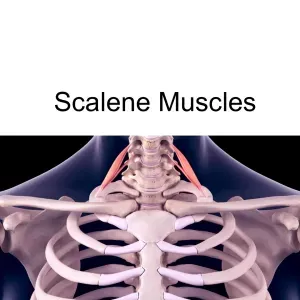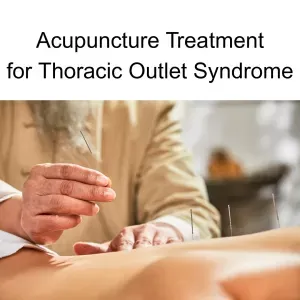By Qineng Tan, L.Ac., Ph.D. and Xiaomei Cai, L.Ac., Ph.D.

Tingling in one arm? Stiff neck and shoulder? Neck pain or headache back of head? These can be symptoms of thoracic outlet syndrome (TOS), or compression of the nerves and blood vessels that run through the neck and shoulder. Acupuncture and TCM offer thoracic outlet treatment to help relieve pain and numbness in the arm and hand.
Tingling pain and weakness in the arm and hand are the most common signs of thoracic outlet compression syndrome. You might wake up with pins and needles in your arm, or have a feeling of weakness in your hand after lifting things overhead or working for long hours at your computer.
What Causes Thoracic Outlet Syndrome?
There is a narrow space between your top rib and your collarbone, known as the thoracic outlet, through which a complex network of nerves and vessels run, connecting the neck and shoulder to the arm.
These nerves and arteries can become constricted due to tight or misaligned muscles (particularly the scalene or pectoralis minor), poor posture, or repetitive movements at work or while participating in a sport, resulting in impaired circulation, and nerve irritation.

The three scalene muscles (anterior, middle, and posterior) attach the cervical vertebrae of the neck to the top two ribs. Key blood vessels (the brachial plexus, subclavian artery and vein) run through the narrow space between the scalene muscles. When these muscles become tight or pushed out of their proper alignment, this can cause compression or entrapment of the blood vessels, affecting blood flow and sometimes also putting pressure on the ulnar nerve, which extends from the neck all the way down to the hand.
Injury or trauma to the area due to a car accident (such as whiplash) could lead to thoracic outlet syndrome. Sports injuries or simply the repetitive movements involved in a sport could cause thoracic outlet syndrome to develop, particularly movements where the arm is extended above the head, as in swimming or baseball. Physical changes that occur during pregnancy and affect the posture can also aggravate nerves and blood vessels.
People with Ehlers-danlos syndrome may be more prone to developing thoracic outlet syndrome because of instability in the shoulder girdle.
In rare cases, a person might have an extra rib or other anatomical variation, which can contribute to TOS.
Top 10 Symptoms of Thoracic Outlet Syndrome
Symptoms of thoracic outlet compression syndrome can come and go and change over time. Common signs include: tingling and numbness in ring finger or pinky finger, pain in neck, pain in shoulder blade, soreness in the armpit or front of chest.
Common symptoms of thoracic outlet:
- Tingling, numbness, or a “pins and needles” sensation in the arm or hand
- Feeling of fatigue in the arm, or arm feels heavy
- Weakness in the hand grip or difficulty lifting objects, loss of fine motor skills in the hand, clumsiness, dropping things
- Aching pain or tenderness and sensitivity in the neck, shoulder, collarbone or chest, sometimes radiating down the arm
- Shoulder appears to be drooping, slumped posture
- Swelling, discoloration, and/or a sensation of cold in the affected arm or hand
- Headaches, especially pain in the back of the head, headache at the base of the skull
- Loss of muscle in the base of the thumb
- Weak pulse in the affected arm
- Blood clots or deep vein thrombosis
Symptoms like tingling and weakness of the arm and hand usually become worse after the arm has been in an elevated position, performing activities that require the arm to be raised over the head.
Signs of thoracic outlet syndrome can appear similar to those of other conditions, like carpal tunnel syndrome, cubital tunnel syndrome, cervical radiculopathy, or other cervical spine issues. Some of the symptoms of thoracic outlet syndrome are also similar to the symptoms of a heart attack.
Typical Thoracic Outlet Syndrome Therapies
Diagnosis of TOS generally begins with a detailed medical history and physical exam, in which maneuvering the arm or neck rotation may reproduce symptoms. Imaging tests such as X-rays, MRI, CT scans, or Doppler ultrasound help assess anatomical contributors and vascular involvement. Nerve conduction studies can also confirm nerve compression.
Conventional treatment for thoracic outlet syndrome typically starts conservatively. A central focus is on physical therapy, aimed at stretching tight muscles, improving posture, and strengthening supportive muscle groups. Pain may be managed with medications like NSAIDs or muscle relaxants. If symptoms persist or worsen, interventions such as targeted injections (e.g., botulinum toxin into tight scalene muscles) or surgical options (like first-rib resection) may be suggested.
These methods can offer relief, especially when implemented early. Still, recovery can be prolonged and some patients may experience recurring symptoms. Acupuncture and TCM offer alternative management for thoracic outlet syndrome.
Can Acupuncture Help Thoracic Outlet Syndrome?

In Traditional Chinese Medicine, thoracic outlet syndrome is viewed as a problem of Qi (energy) and blood stagnation within the meridians that traverse the neck and shoulders, especially the Liver, Gallbladder, and Lung channels. Emotional stress, poor posture, or physical strain may disrupt the smooth flow of Qi, leading to obstructions that manifest as pain, numbness, or movement difficulty.
Additional contributing factors may include Wind-Cold-Damp invasion, which contracts muscles; Liver Qi stagnation, which impairs flexibility; and Spleen or Kidney weakness, which fails to support the body’s structural integrity and recovery.
TCM addresses both the symptomatic blockage and the deeper systemic imbalances underlying the condition.
TCM Treatment for Thoracic Outlet Syndrome
TCM takes a multi-dimensional approach to treating TOS. Acupuncture uses fine needles to stimulate key points that encourage the release of stagnant Qi and improve blood flow.
Cupping and Gua Sha techniques help soften fascia, reduce muscle tension, and encourage lymphatic and blood circulation.
Herbal formulas may include herbs that invigorate blood, relax sinews, and strengthen muscles and fascia.
Lifestyle changes, emphasizing improved posture, ergonomic adjustments, mindful movement, stress management, and dietary tips can help reduce inflammation and support healing.
Controlled trials and case studies suggest acupuncture effectively reduces pain and improves function in conditions involving neurovascular compression. For instance, a controlled study published in 2019 reported significant decreases in pain and disability among patients receiving acupuncture for TOS symptoms.
Another case study found that acupuncture combined with TCM herbal therapy provided thoracic outlet syndrome relief by alleviating shoulder tightness, restoring flexibility, and reducing numbness.
Several clinical groups are exploring acupuncture-mediated modulation of microcirculation, inflammatory markers, and nerve conduction—underscoring its role as a promising complement to standard care.
Acupuncture Near Me for Thoracic Outlet Syndrome in West Los Angeles
TCM modalities are excellent for helping to relieve pain and tingling and improving range of motion for a wide variety of conditions. Acupuncture can provide symptom relief and fundamental improvement of conditions like nutcracker syndrome, carpal tunnel syndrome, cubital tunnel, syndrome, nerve pain, shoulder pain, neck pain, and thoracic outlet syndrome. Drs. Tan and Cai at Art of Wellness in Santa Monica/West Los Angeles have over 35 years of experience in treating vascular and nerve conditions.
*This article is for education from the perspective of Traditional Chinese Medicine only. The education provided by this article is not approved by FDA to diagnose, prevent, treat and cure human diseases. It should not stop you from consulting with your physician for your medical conditions. Traditional Chinese Medicine is based on Qi, which is an invisible force that usually cannot be observed by modern science. Because science focuses on testing ideas about the natural world with evidence obtained through observation, these aspects of acupuncture can’t be studied by science. Therefore acupuncture and Chinese herbs are often not supported by double-blind, randomized trials, and they are considered alternative medicine therapies in the United States.
